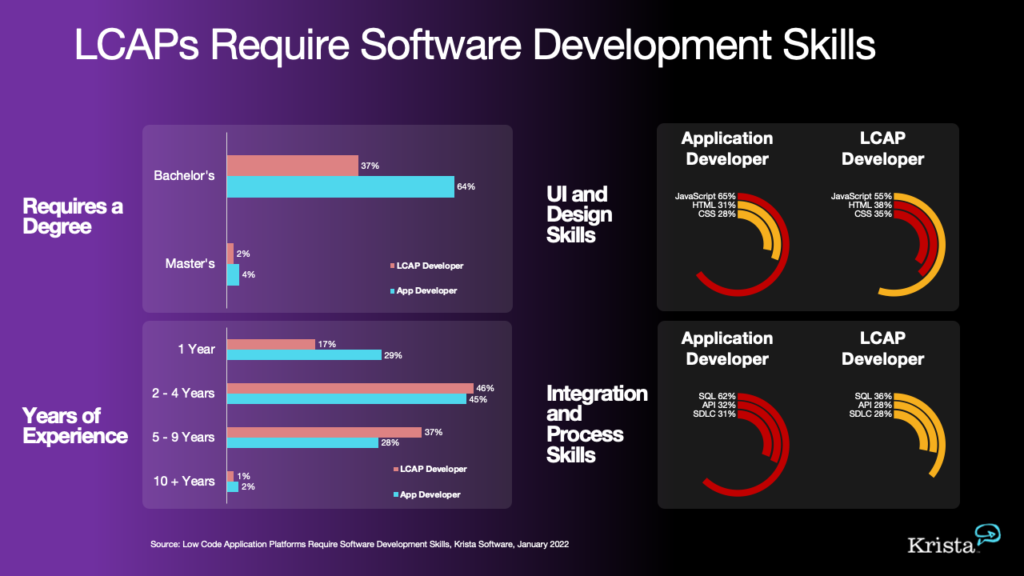Best Advice To Selecting Low-Code Platform Recommendations
Wiki Article
The Advantages Of Low-Code Development For Developing Applications As It Is Related To Integration Capabilities
Low-code app development has many advantages, particularly in terms of integration. This is important to create applications that effortlessly connect to systems and other services. These are the main benefits: Pre-built Connectors and APIs:
A Wide Variety of Connectors. Low-code software typically includes a wide range of pre-built connections to enterprise systems that are popular (e.g. cloud services, databases, CRM). This eases the process of connecting these systems.
API Integration: A lot of platforms offer out-of-the box API integration capabilities. This allows developers to effortlessly connect with data from other sources and services.
Easy To Use
Drag-and-Drop Integration Tasks for integration can typically be completed using drag-and-drop interfaces, making it possible for both developers and non-developers to create complex integrations, without writing lots of code.
Visual Workflow Designers: These tools help you understand and configure integrations with greater ease.
Standardized Integration Methods:
SOAP and RESTful Service: Support for standard web service protocols like REST and SOAP allows for straightforward integration with a wide variety of external systems and applications.
OData and various Standards Standardization like OData provides the easy access and manipulation of data across various platforms and applications.
Real-Time Data Synchronization:
Real-Time Integrations: Low-code systems are able to handle real-time data synchronization between apps and systems, making sure that data is always up-to-date and consistent throughout the company.
Event-Driven Architecture: Some platforms have support for event-driven architectures, which allow applications to react to events in real-time, which is essential for dynamic and interactive applications.
Legacy System Integration:
Low-code platforms are commonly employed to integrate systems from the past. This enables organizations to modernize IT infrastructures without having to completely overhaul existing systems.
Data Migration Tool: Built-in migration tools permit data to be transferred from older systems to new software which are built on low-code platforms.
Third-Party Service Integration:
Integration with Cloud Services: Seamless integration with cloud services such as AWS, Azure, and Google Cloud allows for the simple deployment and scaling of applications.
Business Integration of Applications: Low code platforms can be integrated with various business applications such as Salesforce, SAP and Microsoft Dynamics. This creates a seamless workflow between different business tasks.
Simplified Data management:
Unified Data Models: Certain lowcode platforms have unification of coding models that simplify the management of data as well as integration and synchronization between various systems.
Data Connectors are data connectors that have been pre-configured that provide rapid access to data sources and allow manipulation.
Security and Compliance
Secure Integrations - Low-code platforms have been designed to ensure that all integrations conform to the security protocols and standards. This helps protect the data in transit as well as when it's stored.
The platforms have features to ensure that integrations meet regulatory requirements (e.g. GDPR, HIPAA), giving those who manage sensitive data security.
Extensibility:
Low-code platforms enable the creation of customized scripts and programs to accommodate more complex integration requirements. This flexibility is offered without compromising ease of use.
Plug-in Ecosystems. A community of extensions and plug-ins will allow you to increase the capabilities of integration, while adding new features whenever you need to.
Overall, the low-code platform's integration capabilities can be a very effective tool for developing interconnected apps which are scalable and efficient. These platforms simplify the process of integrating different IT systems, improve the flow of information, and assist businesses adopt existing technologies, as well as leveraging new technologies. Follow the top Low-code Platform for application development for blog recommendations including mobile development platforms, rapid action development, cross platform mobile dev, application modernization software, rapid applications, low code platforms, build a docker container, push alerts, push notifications, app dev platform and more.

Low-Code Applications Are Cost-Effective.
Low-code apps offer many advantages, such as cost-effectiveness. This is a great choice for companies who wish to optimize development budgets without sacrificing quality. Here are the top benefits: Reduced development costs:
Reduced Coding: Low-code platforms minimize the amount of hand-coding required and helps developers save time and energy when creating applications. This results in lower labor costs.
Reduced Developer Resources: Since low-code is faster and simpler to develop, fewer specialized developers will be needed. Costs for hiring and staffing can be significantly reduced.
Faster time to market
Accelerated Development Cycle The visual tools for development and the pre-built parts offered by low-code platforms enable rapid development of applications, which allows companies to bring their products to the market more quickly. This can lead more rapid growth in revenue and enhance your position in the marketplace.
Rapid Prototyping. Businesses can rapidly test and build prototypes. This reduces time spent in the development process and allows for rapid iterations dependent on the feedback of users.
Lower Maintenance Costs
The modular architecture and standardized components of apps developed using low-code platforms makes them simpler to maintain. This reduces the cost of maintenance and support.
Automated Updates - Many low-code platforms can be adapted to managing patches and updates in a manner that's both secure and timely. This eliminates the need for manual intervention.
Efficient Resource Utilization:
Contributions from non-developers: Low code platforms empower non-developers, like business users, to be a part of the process of development. This lets employees and businesses cooperate, and reduces dependence on developers who earn high salaries.
Improved Utilization of IT Resources: IT departments can focus on more strategic endeavors instead of getting bogged down by routine tasks of development, improving overall productivity and efficiency.
The Scalable Pricing model
Subscription-Based Pricing: A lot of lowcode platforms offer flexible, subscription-based pricing models that grow with usage. This enables businesses to align their expenditure with their actual needs and increase.
Pay-Ass-You Go Options: Some platforms have pay-ass-you go options that make sure that businesses only pay for the time they utilize resources. This can be especially helpful for startups and smaller companies with small budgets.
Reduced Third-Party Costs for Software:
Built-in Functionalities: Low code platforms are equipped with a wide range of built-in functions and integrations, which eliminate the need for third-party software and tools. Subscription fees and licensing fees are also reduced.
Pre-Built Integrations: Availability of pre-built integrations with popular systems and services reduces the requirement for custom development, which saves both time and money.
Better ROI:
More efficient return on investment The combination of speedy development, less expensive and quicker time to market mean that companies will see a higher ROI (ROI) for their software.
Improved agility. Companies can adapt quickly to the ever-changing market conditions and customer demands. This will help them remain relevant, and can take advantage of any new opportunities.
Reduced Training Costs
User-Friendly Interfaces: The simple interfaces and user-friendly features of low-code platforms minimize the learning curve reducing the need to conduct extensive training.
Accessible Resources. A lot of low-code platforms offer comprehensive training material including tutorials, training, and community support. They eliminate the need for formal education, which can be costly.
Streamlined Collaboration:
Enhanced Collaboration Tools: The collaboration tools that are built into the software help in communication and coordination between the team members. This leads to a more efficient project development process and lower overhead.
Unified Development Environment: A single integrated development environment helps streamline workflows and reduces the complexities and costs associated with managing multiple tools and platforms.
In general, low-code applications are cost-effective because of their ability to lower costs for development and maintenance, to accelerate time-to-market, to optimize resource usage, and to provide flexible pricing. These aspects provide significant financial advantages to companies which makes low-code development a compelling option for organizations looking to maximize their budgets while delivering solid, reliable, high-quality applications. Have a look at the best Enterprise application development with Low-code Platform for blog tips including app dev platform, azure sql server, app dev platform, application modernization, app development platform, push alerts, push notifications, jdbc server, paas service, azure sql server and more.

Benefits Low-Code App Development In Terms Limitations And Customization
Low-code applications offer a balanced approach that provides significant advantages in terms of dealing with limitations and permitting customisation. Here are a few principal benefits: Handling limitations:
Resolving Complexity:
Simplified Development: Low-code platforms reduce the complexity of development by providing templates and components that are pre-built that allow for rapid development and deployment for more complex applications.
Guided Workflows Many platforms have wizards and workflows to guide developers through complicated processes. This helps to reduce the risk of making mistakes, while ensuring the consistency of.
Scalability Solutions:
Built-In Scalability: Low-code platforms typically include features that allow scalable architecture, allowing applications to handle higher load without significant redevelopment.
Performance Monitoring: Integrating tools for performance monitoring optimization, tuning and monitoring help applications scale efficiently.
Security and compliance
Integrated security features: Low-code platforms have security measures such as encryption, role-based control of access and automated compliance monitoring that address security issues.
Regular Updates: Platforms regularly update their security protocols and compliance measures, ensuring that their applications are secure against the latest threats.
Customization capabilities:
Extensibility:
Low-code platforms are often able to integrate custom code, for instance, JavaScript or Python that allow developers to expand their capabilities beyond the typical.
Custom Modules and Plugins: Developers can have the option of creating custom modules or plugins in order to tailor specific functions to meet the specific requirements of a particular business.
APIs Integration
API Support: Comprehensive API support permits seamless integration of external systems and services. This facilitates the ability to customize and connect.
Third-Party Services: Low code platforms have connectors built for popular third-party services. This makes it easier to build and integrate applications.
Flexible UX/UI:
User-friendly interfaces with customizable options: Users can modify and create their own user interfaces, which can provide a more tailored experience.
Responsive Designs: The software can be tailored to fit various screen sizes and devices.
Custom Business Logic for Businesses:
Visual Workflow Builders: These tools allow developers create complex processes with little or no coding. They are able to design business processes and workflows using visual.
Platforms offer conditional logic to adapt to specific business rules or scenarios.
Data Management:
Custom Data Models: Developers are able to create custom data models to suit specific application needs, ensuring that data handling is customized to the business needs.
Advanced Data Processor: The integration of advanced data-processing tools and capabilities allows for the customization of how data is analysed and used within the application.
Balancing Limitations with Customization:
Frameworks and Standards
Best Practices: Low-code platform encourages adherence to industry standards and best practices. This can be helpful to ensure high-quality secure, scalable, and scalable applications.
Governance Frameworks. Built in governance frameworks can help ensure that customizations are not harmful to the integrity, security or the compliance of an application.
Iterative Development:
Rapid Prototyping. Developers can develop and refine applications based upon feedback from users.
Continuous Improvement: Low-code platforms support constant improvement, allowing continuous customization and improvement as business requirements evolve.
User Empowerment:
Empowering Citizen Entwicklers: By giving non-developers the opportunity to customize their applications through simple interfaces and low-code platforms they boost the number of users who can enhance and customize applications.
Training and support: Many platforms provide extensive training resources and support services to assist users in making modifications that work without compromising an application's performance or stability.
Overall, Low-code application creation offers a framework that is sturdy and adaptable enough to meet limitations while still allowing for the possibility of extensive customization. This balance ensures businesses can develop and maintain applications that are tailored and efficient to meet their individual requirements while maintaining high levels of safety, quality, and scaling.
